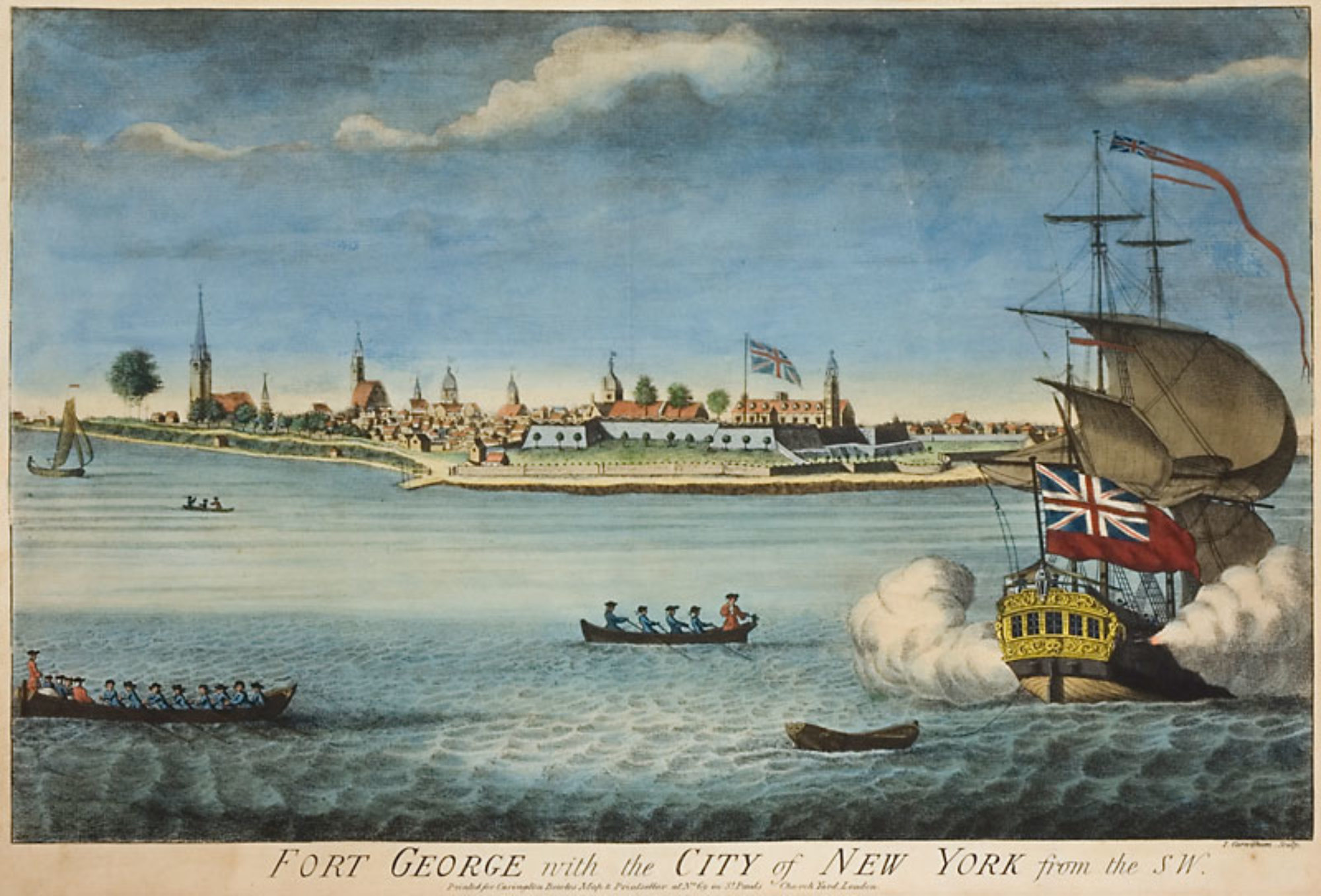
The Hessian Troops (from the Landgraviate of Hesse-Cassel) what is now part of Germany had arrived at Staten Island on August 12, 1776. A Hessian soldier, Major Carl Leopold Baurmeister recalled in his journal that the Hessian troops had camped on the Island on the 14th and 15th of August. He noted that 132 soldiers were hospitalized on the Island, possibly from scurvy. He recalls:
“We found the English troops, which had been driven out of Boston encamped on Staten Island on 8 different heights. 1) At Amboy Ferry, Lieutenant General Clinton with 2 brigades and half of an artillery brigade. 2) Between Amboy Ferry and the Old Blazing Star (present-day Rossville) Brigadier General Leslie with 3 brigades and half an artillery brigade. 3) At the Old Blazing Star, Brigadier General Farrington with 2 brigades and 2 twelve-pounders and also half a troop of light dragoons to carry dispatches. 4) At the New Blazing Star, Brigadier Generals Smith, Robertson and Agnew with 3 brigades and the other half of the troops of light dragoons. 5) At Musgrove’s [Lein], Lieutenant General Percy and Brigadier General Erphine with 2 brigades and four 6-pounders and one officer and 25 light dragoons. 6) At the Morning Star (at the foot of present-day Clove Road) Lieutenant General Cornwallis with 2 1/2 brigades, six 12-pounders, 4 howitzers, and 15 dragoons. 7) At Decker’s Ferry (now Port Richmond) Major General William Jones with the 37th and 52nd regiment and light guns. 8) To the right of Decker’s Ferry in a country house [Kruzer-Pelton House] close to the shore opposite New Jersey, Major General Vaughan with 6 grenadier battalions, the 46th regiment and the rest of the disembarked artillery, the rest of the light dragoons, and General Howe’s headquarters.” [1]

Baurmeister reports that 500 Staten Island militia and “the disloyal inhabitants of Staten Island had their arms taken from them, and the militia were assigned stations in case of an attack from Jersey.”
On the 12th of October, Baurmeister recorded in his journal that
“Colonel von Lossberg’s brigade, excepting the Regiment von Trambach, embarked on thirteen transports at Staten Island and remained on board ship until the 17th.
These troops had scarcely vacated the island, leaving only the trenches occupied, when the rebels crossed over at [Perth] Amboy and Elizabethtown. They made the roads to Richmond unsafe burned some houses, set fire to the old camps, and captured some patrol which Lieutenant Dalrymple had needlessly sent from the trench to the said village. Lieutenant Clewe and eight men of von Triimbach’s Regiment were among those captured. The Lieutenant got away, but the eight soldiers were taken to Philadelphia, where they were well treated and promised great rewards if they would enlist in the rebel army.”
Approximately 6,000 Hesse-Cassel troops participated in the assault on Fort Washington in upper Manhattan, which ultimately resulted in the Americans surrendering to the German Commander in Chief Knyphausen.
For 1777, the diary of Captain Johann Ewald records:
“During the night of the [June] 28th and early morning of the 29th the greater part of the army crossed over Prince’s Bay to Staten Island. The rear guard under Lord Cornwallis, consisting of the jagers, the light infantry, and both Highland regiments, crossed the bay toward evening on the 30th. The entire army took up camp from Billop’s Ferry to Richmond.
The 1st of July. Today all the officers of the army were notified that they could sell their horses to the Hessian mounted jagers and to the artillery park for ten guineas apiece, since no one up to the grade of colonel would be permitted to take a horse with him on the imminent expedition. By this order, the mounted jagers received their mounts in
the nicest manner in the space of two days. After this order I proceeded at once to the headquarters to report that I was still completely incapable of doing my service on foot because of my hard fall on my right leg, whereupon I was permitted to take a horse with me.
On the 3d of July it was ordered that the following corps and regiments would hold themselves ready for embarkation:
- The Jäger Corps, which now consisted of three Hessian, one Anspach,
and one mounted company, each being made up of 173 men. - Two battalions of light infantry.
- Two battalions of English grenadiers and the English Guards.
- The three Hessian grenadier battalions, von Linsing, Lengerke, and
Minnigerode. - [Number 5 is missing.]
- The English Guards.
- The Queen’s Rangers, and Ferguson’s sharpshooters, which had recently
arrived from England. - Five English brigades.
- Two Hessian brigades.
- A part of the heavy artillery.
- The two light dragoon regiments.
- The 71st Scottish Regiment. Note: Is already counted as the 5th
Brigade.
In all, these troops amounted to about fifteen thousand men, and the generals accompanying them, besides General Howe, were LordCornwallis, Grant, Grey, Agnew, Knyphausen, and Stirn. Today the recall of General von Heister came from Hesse, and General von Knyphausen received the command of the Hessian troops. From the 4th up to the 9th, this entire army was embarked with everything that was necessary for the expedition at Decker’s Ferry, Cole’sFerry, Simonsen’s Ferry, and Reisen’s Ferry on Staten Island.
Since the wind was constantly easterly, the fleet remained at anchor between Long Island and Staten Island in the vicinity of Denys’s Ferry up to the 19th. But on the morning of the 20th, about nine o’clock, a light wind arose, whereupon the fleet weighed anchor and put to sea on the same day.[2]

Sources: [1] Revolution in America: Confidential Letters and Journals 1776-1784 of Adjutant General Major Baurmeister of the Hessian Forces, trans. Bernhard A. Uhlendorf, Rutgers University Press (New Brunswick, New Jersey 1957)
[2] Diary of the American War: A Hessian Journal, Captain Johann Ewald, Field Jäger Corps trans. and ed. Joseph P. Tustin, Yale University Press (New Haven and London, 1979)

